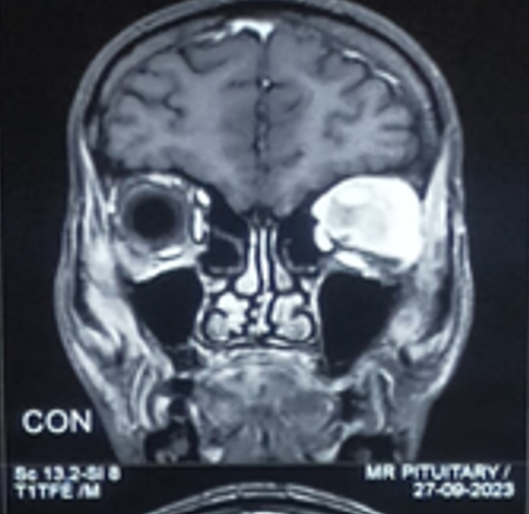Coexistence of Pituitary Macroadenoma and Dacryoadenitis: A Complex Presentation in a Patient.
Keywords:
Pituitary Macroadenoma, Dacryoadenitis, Bitemporal HemianopsiaAbstract
Pituitary adenomas are slow-growing, benign tumors of the anterior pituitary gland. While their small size usually makes their presence unknown, macroadenomas may cause clinical symptoms due to their mass effect. Dacryoadenitis is inflammation of the lacrimal gland, usually associated with infection. This case report details the clinical assessment and diagnostic journey of a 57-year-old male farmer, J.M., presenting with a constellation of symptoms including bilateral visual deterioration, persistent headaches, and left eye protrusion. Clinical examinations, imaging studies, and histological findings culminated in the identification of a coexisting pituitary macroadenoma and dacryoadenitis. This report highlights the challenges in diagnosing and managing such intricate presentations and emphasizes the necessity of interdisciplinary collaboration for accurate diagnosis and tailored treatment plans. Advancements in minimally invasive surgical techniques and targeted medical therapies have significantly improved patient outcomes and reduced treatment-related morbidity. Future practice should focus on early recognition and effective management of these complex presentations to enhance patient quality of life.
References
Russ S, Anastasopoulou C, Shafiq I. Pituitary Adenoma. In: StatPearls [Internet]. Treasure Island (FL): StatPearls Publishing; 2023 [cited 2023 Dec 10]. Available from: http://www.ncbi.nlm.nih.gov/books/NBK554451/
Molitch ME. Diagnosis and Treatment of Pituitary Adenomas: A Review. JAMA. 2017 Feb 7;317(5):516–24.
Araujo-Castro M, Berrocal VR, Pascual-Corrales E. Pituitary tumors: epidemiology and clinical presentation spectrum. Hormones (Athens). 2020 Jun;19(2):145–55.
Patel R, Patel BC. Dacryoadenitis. In: StatPearls [Internet]. Treasure Island (FL): StatPearls Publishing; 2023 [cited 2023 Dec 10]. Available from: http://www.ncbi.nlm.nih.gov/books/NBK535384/
Ho RW, Huang HM, Ho JT. The influence of pituitary adenoma size on vision and visual outcomes after trans-sphenoidal adenectomy: a report of 78 cases. Journal of the Chinese Medical Association. 2013 Oct 1;76(10):566-71.
Jefferson G. Extrasellar extensions of pituitary adenomas. Proceedings of the Royal Society of Medicine. 1957 Jan;50(1):17.
Moradi Tabriz H, Mollahoseini R, Sadramely MR, Khodadadi K, Sabet MS, Sharifi G, Rahimi-Movaghar V. Visual outcome after surgery in patients with pituitary adenoma: A 15-year survey. Iranian Journal of Neurosurgery. 2018 Jan 1;4(1):23-7.
Briet C, Salenave S, Chanson P. Pituitary apoplexy. Endocrinology and Metabolism Clinics. 2015 Mar 1;44(1):199-209.
Raverot G, Vasiljevic A, Jouanneau E, Trouillas J. A comprehensive review of features of somatoproliferative tumor cells. Clinical Endocrinology. 2008;69(4):609-17.
Olson MC, Hizel LP, Allen CM, Swanson JW, Gilmore JL. Successful Treatment of a Recurrent Lacrimal Gland Mass Using Radiotherapy. Mayo Clinic Proceedings. 2001 Feb 1;76(2):205-9

Downloads
Published
How to Cite
License
Copyright (c) 2025 East African Journal of Neurological Sciences

This work is licensed under a Creative Commons Attribution-NonCommercial-NoDerivatives 4.0 International License.

